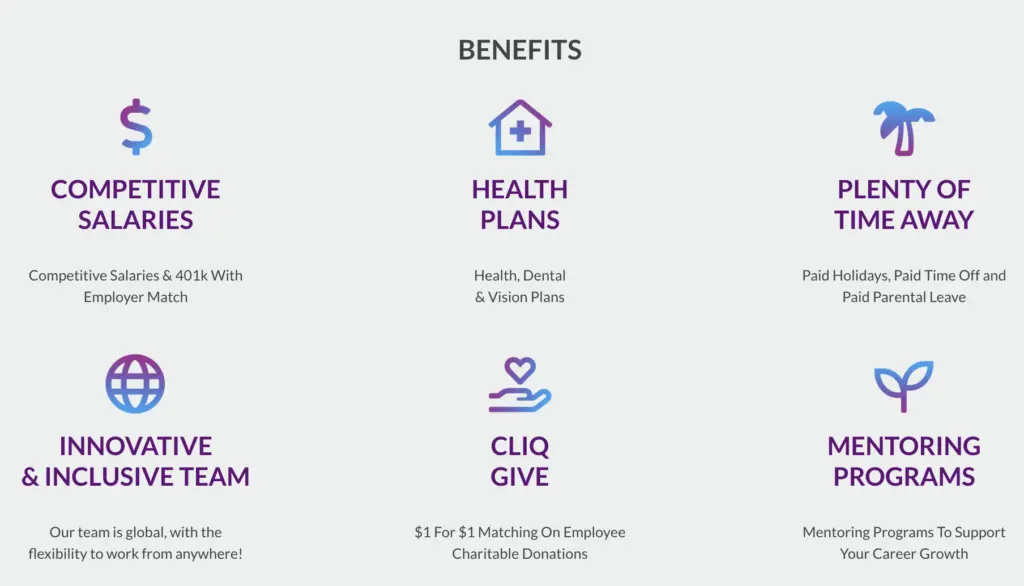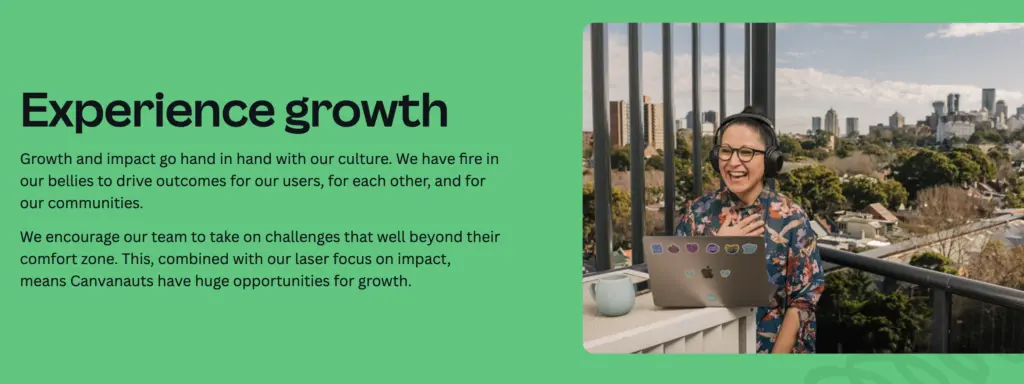The employer-employee dynamic has historically favored the employer to such a degree that most companies rarely put much thought into their value proposition to workers. The environment has definitely changed, and not just because of the global pandemic (although that was a contributing factor). Tight labor markets and increasingly large skills gaps mean companies must have a strong employee value proposition or EVP. Long story short here: If you want the best employees, you need to be able to express why working for you is better than working for someone else.
Your EVP can be delivered in many different ways, but it boils down to a set of values that you’ve outwardly expressed and advertised that help to attract talent to your business. 56% of workers won’t even consider a workplace that doesn’t share their values. It is a vital part of your company’s brand as it can speak authentically to the values someone will see lived out when they join your company. Gartner shows that organizations that effectively deliver on their EVP can:
- Decrease annual employee turnover by 69%.
- Increase their new hire commitment by almost 30%.
Let’s further break down what an EVP is, why your business needs to have one, how to create one, and example of how other companies have marketed to great success.
Take It With You
Download our free ebook on Why Employees Leave and how mentoring programs increase retention and save companies millions of dollars in turnover costs
What is an employee value proposition?
An EVP can be very simply summed up as the promise a company makes to its employees and what it intends to offer them in return for their hard work and time spent. It sends a clear message and should speak to potential candidates viewing your job adverts, as well as your existing employees who want to stay at your company.
Having an EVP effectively gives you a blueprint for what you want your brand to look like. It should deliver clarity regarding important values at the heart of your company, like your identity and culture.
Why Is an Employee Value Proposition Important?
You don’t have to work in an HR, talent development, or other leadership role for very long to realize that employees are, well, dissatisfied with their companies and managers. While pay is important to workers, it’s simply not enough to ensure higher retention and better productivity.
In its 2023 Workmonitor report, Randstand found that:
- 94% of people say work-life balance is important
- 48% of people would quit if their work didn’t alllow them to enjoy life
- 45% would reject a job offer if the employer couldn’t guarantee schedule flexibility
In fact, in its sections on “tips for a changing workforce expectations”, Randstand’s primary feedback for companies is to explore ways to ensure a better work-life balance and how to incorporate more remote work flexibility into job roles. It highlights this need even within the context of reducing employees’ financial burdens (partciularly those related to commuting).
This doesn’t cover the whole topic, but it should help underscore just why a stated employee value proposition is essential.
An EVP can help you attract and retain top talent
Who doesn’t want the best of the best working for them?
Understandably, any company that wants to work with top talent needs to make persuade them to take the time to submit an application. While hiring managers often groan over the poor quality of most applications, top talent will take the time to needed to submit a quality application, but only for jobs they actually want.
That said, attracting those high quality workers is only part of the process. Companies also need to ensure they do not offer false promises and truly are the great places to work that they claim to be.
An EVP is great for attracting the right people to your company, but it should be delivered on to retain employees and deliver on their expectations.
Build a corporate culture people want to work for

Any company can put together an attractive benefits package and bring the right candidate on board. It is, however, an entirely different thing to build a company or team culture with a strong employer brand that people are proud to work for.
A compelling employee value proposition should offer exactly this: A strong company story with values that speak to each of your workers. Employ, Inc. found that 55% of people would quit if they discovered the culture and values of their company didn’t align with their own.
An EVP is a great way to formalize a your efforts to become a company that people want to work for, but that’s not going to go far if you’re not also living up to those value in practice.
Optimize and speed up recruitment process
Recruitment can be a long, difficult, and expensive process. Even if using the aid of recruiting agencies and other experts, there is no guarantee that you will see the quality of candidates that you expect to receive.
Having a strong employee value proposition on offer to potential employees right there on your careers page signals what you offer. It gives job seekers a clear idea of what environment the company offers. This can help streamline and optimize the overall recruitment strategy and ensure that only interested candidates reach the interview stage.
Again, put your words into action. Employ technology and standardized processes where you can that will where you can that will. If you’re not already, look deeper into AI-based tools that for recruiting, interviewing, and hiring. As always, make sure those tools function ethically, as automated tools can be an DEI nightmare if not properly managed.
What makes a great employee value proposition?
A compelling EVP is not something you whip up in an hour or two. It should be authentic and should speak to what you want to offer as a business. Here’s what effective employee value propositions look like. Here, we’ll discuss different topic areas you may want to include on your EVP.
Financial compensation
While I’ve puta good number of calorties and text real-estate explaining why employees want something other than money, financial compensation is still a top want from employees (and likely always will be, as long as money is needed to live).
Your EVP won’t and shouldn’t be so detailed that it discusses every single pay band for every role. However, there can still be clear indicators of a commitment to comfortable and competitive financial compensation. For example, a business might commit to offering a living wage to its lowest-paid employees or might be open about how their bonuses and investing options work.
One need only look as far as Gravity Payments and its now embattled CEO Dan Price to see how that can play out. Price’s commitment to paying employees’ a starting minimum of $70,000 per year helped vault the company’s profile. It was an exceptionally attractive employee value proposition at a time when fair pay was already a trending topic and one the company has maintained as a key part of its company persona.
Clarity, fairness, and competitiveness with your financial compensation allows employees to successfully plan their finances. By promoting better financial health among employees, they will feel more comfortable and secure in their positions.
Employee benefits
A job’s compensation goes much further than a salary. Businesses should try to tailor their benefits package to the industry that they are in so that they can actively compete with competitors. Benefits typically include 401(k) plans, paid vacation time, health insurance, and other essential perks.
These benefits can also include other perks unique to the company. Google offers employees on-site meals and snacks, fitness and well-being activities, and even the chance to attend cooking classes. These can all feed into the overall perception of the business. A positive work environment might not just be one that pays well and doesn’t offer high levels of stress; it might also be one that supports its employees with a wide range of benefits.
Learning and development
A vital part of the employee experience will be the learning and development process. Every employee should be offered the chance to grow personally and professionally within the context of their work. An EVP should list some of the development opportunities an employee could explore in their time at the company.
Development opportunities can vary widely depending on the business and industry. For example, a graduate scheme might offer the chance to cycle between different departments before settling on a specialty. Mentoring schemes can also help people at all stages of their careers establish new connections and build on knowledge. It can be a great source of personal and professional growth, whether they are leaders or just starting out.
Work environment
We always need to maintain a work-life balance no matter how stressful things might become. An employer’s commitment to maintaining a positive working environment can be a great example of this.
It can start with something as easy as an office space (with a lot of natural lights, ergonomic chairs, and modular furniture, to name a few), a budget for a home office setup, or a policy regarding remote or hybrid work. It could even include policies on management interaction and employee recognition.
Company culture
Company culture can be defined in many different ways. It can be the company values — hence why it is such a critical part of the EVP — but it can also be used to describe how you socialize and mix teams, how you plan collaboration, and how you approach fun.
Support systems like employee resource groups (ERGs) can also help marginalized communities feel welcome in the wider company too. If you have support systems in your business, be they formal structures like ERGs or a buddy system or just informal groups like lunch buddies, then you should shout about them loud and proud.
What do you need to do to build a brilliant employee value proposition?
Building an effective employee value proposition is a process composed of several different parts:
- Understanding what your business has to offer employees
- Working with stakeholders across your organization on what areas matters most to attract new talent
- Drafting the value proposition in words
- Promoting the new EVP across multiple channels
Once your EVP is done, it should become a bedrock not only for your recruitment process, but also for existing employee retention, as well.
Know what you offer
Do you know what your company offers? You can’t expect to attract the talented professionals you want if you don’t actually know what makes your employer brand stand out from all the others in your industry.
Work together with other HR and executive leaders to iron out what your company offers to employees that lead to better retention, development, and growth. Don’t sugarcoat it and definitely don’t embellish your benefits and culture.
If you know you’re coming up short in several key areas, acknowledge that as a team, but find other aspects that you can focus on that potential employees may be attracted to. Only then will you be able to make realistic changes across the board that then lead to transformation within the company at large.
Bring employee feedback on board

Talk to current and past employees to find out what they think about your existing culture and benefits. What do they love about your company? What do they wish would change? Are there areas where they would like to see change?
As an example, you might already offer an informal mentoring scheme to help employees up the career ladder. However, the scheme has little engagement as mentor-mentee matching has to be done by hand and is considered to be quite time-consuming. You don’t want to lose the benefits of mentoring, but switching to a mentoring software with automated matching might be the better option for you.
Define what you want
What do you want to see from your company? Do you want employees to feel pride in their work and what they do for you? Do you want them to actively advocate for your services?
These are all important metrics that could be the results of a good EVP. As with other business goals, it is important to set a realistic deadline or endpoint that the company can work towards. Though the primary goal of the EVP is to bring enrichment and security to employees, it can also be used to define future aspirations for the company. A company’s EVP should be an employee-centered approach to creating value, and that can’t be done unless management has an idea about what they wish to see.
Put it in writing
As with other processes and policies, employee value propositions should be written down when they have been finalized. They should be displayed prominently on the business’s website for visitors to see, and should form part of an employee handbook or other document that current employees have access to.
Having the EVP in writing also formalizes the agreement. It gives both employees and management an understanding of what is available to them. Employees should understand the training and development available to them, in addition to what they are entitled to via benefits and financial compensation. Management should know what is expected of them and the tools at their disposal when required to deliver effective guidance.
Promote the new EVP
Don’t let the new EVP become just another document that fades away into obscurity! This is a vital part of an employer brand, and so it should be adequately promoted.
An internal communications campaign can be the best way to get eyes on it at first. Emailing it to every employee gives them a chance to read through it and absorb what is being offered to them. Just uploading the EVP somewhere without drawing any attention to it carries a real risk that no one will actually know what the company can offer them.
Let’s imagine you were launching a new benefit for employees, such as career development mentoring, where workers would have the chance to shadow a senior employee and gain valuable experience in what that role entails. But, no one signs up. At all. It would be easy to write the scheme off as a failure and a waste of resources until you notice that it was not promoted in the first place.
Employees can often end up focused on their tasks and deadlines, and so never realize what else the company can offer them. Direct attention to the employee value proposition, and employees will hopefully begin to engage with it.
Review, and maybe rewrite
Every process needs to be reviewed and potentially rewritten if it is not delivering the intended result. If the EVP does not deliver true value to employees, then it needs to be amended. Employee surveys are an excellent way to hear back from workers, and making such feedback anonymous can help people speak their minds without worrying about repercussions.
An EVP may also shift as the labor market moves too. After all, each generation wants something a little different from their workplaces. As Gen Z firmly finds their place in the workplace and rises comfortably into management, we may see some changes to corporate culture since they approach the world of work differently from others.
What do great employee value proposition examples look like?
An employee value proposition will obviously look a little different for every company, as it should speak to the company’s values. Every company will have something that appeals to them that others might not, and this is exactly what an EVP should shout about loud and proud.
Not sure what a great employee value proposition might look like? Here are some of our favorites to give you a little idea about what to expect from an EVP.
MentorcliQ
I joined MentorcliQ in 2021 following a successful recruitment for an unadvertised position. I also had no reason to make a switch — I had already built a successful freelance writing career. But MentorcliQ’s strong EVP drew me in.

If you head over to our careers page, and you can see why. MentorcliQ’s core values (which are also a key part of the hiring process), are what we call FunHAT: Fun, Helpful, Ambitious, and Thoughtful. This embodies the culture at MentorcliQ quite well, from the meme-filled team chats to the daily dedication to going above and beyond for the team and for each other.
MentorcliQ also highlights the core benefits of employees broadly on the website in a way that’s designed to build interest from potential applicants.
Canva
As you might expect from a company like Canva, its approach to displaying its EVP is as graphically appealing as it is appealing from a “I would love to work there!” standpoint. Their Life at Canva portal serves as an introduction to the company and the many schemes they have running behind the scenes.

From their Canva Collectives — offering safe community spaces for marginalized communities — to their growth philosophy, they make sure to outline what every aspect of life at Canva might look like to a potential employee.
Netflix
Streaming giant Netflix would be a dream employer for many. The company recognizes the value that it brings to the world of entertainment and try to make sure that this is reflected in their job site. With everything neatly summed up in their Seeking Excellence blog post, potential candidates have a clear idea as to the specific behaviors and values that they care about the most.
While the presentation method of its EVP is far from glitzy, it gets the job done with a clearly-stated value proposition to potential hires.
Netflix also recognizes that business can be difficult at times, and so they outline what would happen during issues. By describing their Informed Captains and Disagree Then Commit policies here in their EVP, they can actually attract interest since they have been so honest and realistic about what might happen when the company encounters a disagreement.
In a way, Netflix’s approach to it’s EVP is as strategic as it is informative. The type of people who takes the time to read the while culture document is probably the type of person Netflix wants to hire in the first place.
Mentoring Is a Key Compontent in an Employee Value Proposition
In our Mentoring Impact Report, we found that 98% of Fortune 500 companies now have mentoring programs, and 100% of Fair360’s Top Companies for Diversity have both employee resources groups and mentoring programs. A large number of these companies make the presence of ERGs and mentoring a key part of their employee value proposition.
What’s more, the number of companies realizing that employee development is a must have value prop is growing. In the early 2000s, the number of companies with mentoring programs was just 70%. That it’s now 98% highlights just how much HR and talent development leaders at leading companies have recongized the value in mentoring as a solution to employee attraction and retention.
But, as we’ve iterated already multiple times: You have to walk the talk. It’s not enough to say you have mentoring. You have to actually provide it. For that, you need a platform that ensures everyone can have a mentor, when they need one, and in a way that supports the needs of the business, and the needs of the employee.
That’s where MentorcliQ comes in. MentorcliQ’s platform is designed with flexible and scalable employee development in mind. By leveraging the power of award-winning software, MentorcliQ allows you to launch the type of programs you want or need, match participants quickly and effectively, engage them consistently, and measure the success of your programs so you can prove it’s more than just a marketing tactic.




